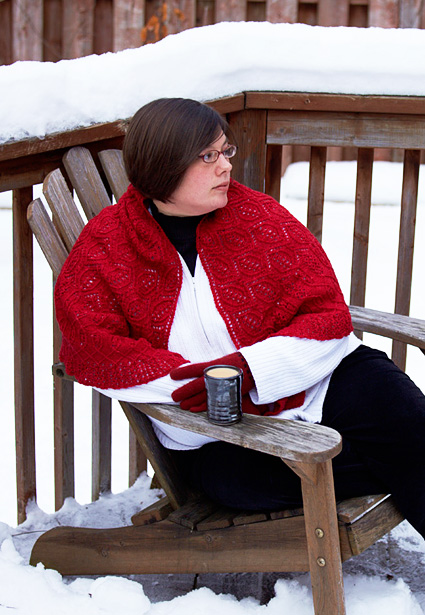

|
|
|
 |
I was paging through Japanese stitch dictionaries and found the main pattern used in this shawl. It reminded me of an Egyptian cartouche and I visualized it in a deeper vibrant red, the colour of life and victory for Ancient Egyptians. In this top-down shawl, the stitch patterns flow seamlessly one into another. To accomplish this, transitional charts are used. These are marked as such and must be followed with extra care as stitch patterns are altered to flow into the next design. |
|
|
|
|
SIZE |
|
FINISHED MEASUREMENTS |
|
MATERIALS Notions |
|
GAUGE |
21.25 sts/41.25 rows = 4 inches in the lace pattern from Chart A, after blocking |
|
PATTERN NOTES |
| Each
chart shows only the stitches
between markers 1 and 2
and the centre “spine” stitches. The
chart must then be repeated across the
stitches between markers 3 and 4.
When a yarnover is followed by a purl stitch, do not wrap the yarn around the needle. Simply take yarn to the back and work the purl stitch, allowing the yarn to lay over the needle. Hb yo - Horizontal bar yarnover - with right
needle, pick up 3rd stitch on left needle
and pull over 1st and 2nd stitch and drop, creating a horizontal
bar under the stitches, then k1, yo, k1.
Note: Be very careful when working the
double decreases. Both s2kpo and sk2po are
used, and there is a difference in
how they look – make
sure you use the right one. Instructions for the Knit Lace Bind-Off can be found
here (middle technique). |
Chart A • Chart B1 • Chart B2 • Chart B3 • Charts C + E • Charts D1 + D2 |
|
DIRECTIONS With right side (RS) facing, knit across the 3 stitches on your needle. Turn work 90 degrees clockwise and pick up and knit a stitch in the edge of each garter stitch ridge. Turn work 90 degrees clockwise and pick up 3 stitches in the cast on edge (15 stitches). Turn work so wrong side (WS) is facing. Setup row [WS]: K3, pm, p3, pm, p3, pm, p3, pm, k3. Chart A Continue in pattern as established until Chart row 42 is complete. At the end of the Chart A you should have 45 stitches between markers 1 and 2 and between markers 3 and 4. 99 stitches total. Charts B1-3 Note: If you wish to make a larger shawl, work an extra repeat or two of the 44 row repeat in this section. If a larger size is worked, additional yardage will be required. To make the shawl smaller, work fewer repeats. If you adjust the number of repeats, make sure you end on row 24. After Charts B1-3 are complete you will have 157 stitches between markers 1 and 2 and between markers 3 and 4. 323 stitches total. Chart CWork chart C once, continuing to work k3 at the beginning and end of each row. Note: Work this section with extra care. The stitch pattern is close to the one in chart B but this section of chart handles the transition to the new stitch pattern in chart D, and there are differences. At the end of Chart C, you should have 167 stitches between markers 1 and 2 and between markers 3 and 4. 343 stitches total. Charts D1-2 Note: As indicated on the chart legend, the first stitch of chart D1 is a yo. For subsequent stitch repeats, work this stitch as a purl. Note: See the pattern notes for instructions on working the stitches that create the flower buds (comprised of the inc3, p3 and sk2po over three rows). At the end of Charts D1 & 2 you should have 217 stitches between between markers 1 and 2 and between markers 3 and 4. 443 stitches total. Chart EWork Chart E once, continuing to work k3 at the beginning and end of each row. At the end of the Chart E you should have 289 stitches between between markers 1 and 2 and between markers 3 and 4. 587 stitches total. |
|
FINISHING Weave in all ends. Soak shawl in lukewarm water with a wool wash until the yarn is thoroughly saturated. Roll shawl in a towel and gently squeeze to remove excess water. Stretch piece to desired measurement and pin in flat to dry (it is highly recommended that blocking wires be used for this). Do not unpin until completely dry. |
| ABOUT THE DESIGNER |
|
Janelle has been an avid knitter for the past 27 years but has only recently started designing and writing patterns. Her current fascination is with Japanese Stitch Patterns. She lives in Waterloo, ON, Canada, and rarely goes anywhere without a book and her knitting. You can find her designs on eclecticcloset.ca and she’s Antheras on Ravelry. |
|
Pattern & images © 2011 Janelle Martin. Contact Janelle |